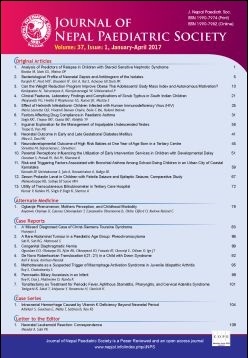Utility of Transcutaneous Bilirubinometer in Tertiary Care Hospital
DOI:
https://doi.org/10.3126/jnps.v37i1.17117Keywords:
Hyperbilirubinemia, Transcutaneous bilirubinometer, Serum bilirubinAbstract
Introduction: Hyperbilirubinemia is one of the most vexing problems that may occur in 60% of term and 80% of preterm neonates. In order to reduce the risk of developing serious hyperbilirubinemia, it is vital to identify jaundiced infants who are in need of treatment as soon as possible. The objectives of this study were to find whether transcutaneous bilirubin (TcB) measurement correlates with total serum bilirubin (TSB) levels, measured with standard laboratory method and to analyse the effect of gestational age, birth weight and postnatal life on TcB and TSB.
Material and Methods: A prospective study was conducted in the Department of Paediatrics, Government Medical College, Amritsar on 300 neonates with visible jaundice. These neonates were divided into various groups depending upon gestational age, birth weight and day of life. TcB readings were recorded at forehead and sternum and serum bilirubin level was measured within 30 minutes. Test of significance applied was unpaired T-test; mean value, p-value, standard deviation and Pearson's correlation coefficient 'r' were calculated.
Results: Overall Mean value TcB at forehead was 15.32 with SD ± 2.75, mean TcB at sternum was 14.94 with SD ±2.51, mean value of TSB was 13.80 with SD ±2.15. Pearson’s correlation coefficient r was 0.895 for TcB forehead vs TSB, 0.903 for TcB sternum vs TSB and 0.966 between TcB forehead vs TcB sternum.
Conclusion: TcB levels correlates well with the gold standard measurement of TSB. Gestational age, birth weight and day of life had no effect on TcB and TSB correlation. Transcutaneous bilirubinometer can thus be used to measure bilirubin level as a screening method for neonatal hyperbilirubinemia.
Downloads
Downloads
Published
How to Cite
Issue
Section
License
Authors who publish with this journal agree to the following terms:
Authors retain copyright and grant the journal right of first publication with the work simultaneously licensed under a Creative Commons Attribution License that allows others to share the work with an acknowledgement of the work's authorship and initial publication in this journal.
Authors are able to enter into separate, additional contractual arrangements for the non-exclusive distribution of the journal's published version of the work (e.g., post it to an institutional repository or publish it in a book), with an acknowledgement of its initial publication in this journal.
Authors are permitted and encouraged to post their work online (e.g., in institutional repositories or on their website) prior to and during the submission process, as it can lead to productive exchanges, as well as earlier and greater citation of published work (See The Effect of Open Access).



